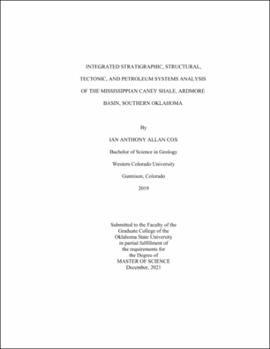| dc.contributor.advisor | Pashin, Jack C. | |
| dc.contributor.author | Cox, Ian Anthony Allan | |
| dc.date.accessioned | 2022-05-13T19:05:08Z | |
| dc.date.available | 2022-05-13T19:05:08Z | |
| dc.date.issued | 2021-12 | |
| dc.identifier.uri | https://hdl.handle.net/11244/335757 | |
| dc.description.abstract | Burial and thermal history modeling were used to assess the thermal maturity of the Mississippian (Chesterian) Caney Shale in the Ardmore Basin, southern Oklahoma, to determine the formation's viability as an unconventional oil and gas play. All models display a similar tectonic evolution with subsidence during and following Cambrian Iapetan rifting, tectonic stability during a passive margin phase from the Silurian-Late Mississippian, synorogenic subsidence during the Pennsylvanian, post-orogenic subsidence during the Permian, regional uplift and unroofing from the Late Permian to Early Cretaceous and Gulf of Mexico Coastal Plain subsidence during the Early Cretaceous to Paleogene. Rapid, episodic Pennsylvanian subsidence appears to have been synchronous with sequential uplift of the Wichita Mountains and then the Arbuckle Mountains in response to major left-lateral transpression. The rapidity of subsidence suggests that the Ardmore Basin functioned episodically as an elevator basin, which is typical of sedimentary basins in oblique-slip mobile zones. | |
| dc.description.abstract | Calculated vitrinite reflectance and geothermal gradients were calibrated to measured vitrinite reflectance and temperature data (corrected bottom-hole temperatures) respectively, to ensure model validity. A source of uncertainty is modeling Permian-Cretaceous erosion. Calibration of these models requires erosion of approximately 5,000 ft of strata. The eroded overburden section was not uniformly distributed, as areas of high structural relief, such as the Arbuckle Uplift, appear to have had significantly less sediment cover than the basin proper. Regional variation in the thickness of eroded Permian sediment, which apparently formed a wedge that thickened toward the Anadarko Basin, and the Cretaceous-Paleogene Gulf of Mexico sedimentary wedge, which apparently thickened southeastward, affected the burial and maturation history of the Ardmore Basin. Regional thermal maturation was apparently arrested during Mesozoic-Cenozoic unroofing of the basin. | |
| dc.description.abstract | The Devonian-Mississippian shale section has a broad range of thermal maturity ranging from immature (Ro <0.6%) to the dry gas window (Ro >2.0%). Thermal maturity is strongly dependent on structural position, with immature strata preserved in the flanks of the uplifts and highly mature strata preserved in the synclines. Variations in heat flow related to thermal conductivity, structural history, and general variability of organic composition, particularly at low maturity levels, have resulted in a modest degree of scatter in the reflectance-depth data. | |
| dc.format | application/pdf | |
| dc.language | en_US | |
| dc.rights | Copyright is held by the author who has granted the Oklahoma State University Library the non-exclusive right to share this material in its institutional repository. Contact Digital Library Services at lib-dls@okstate.edu or 405-744-9161 for the permission policy on the use, reproduction or distribution of this material. | |
| dc.title | Integrated stratigraphic, structural, tectonic, and petroleum systems analysis of the Mississippian Caney Shale, Ardmore Basin, southern Oklahoma | |
| dc.contributor.committeeMember | Abdelsalam, Mohamed G. | |
| dc.contributor.committeeMember | Puckette, James O. | |
| osu.filename | Cox_okstate_0664M_17495.pdf | |
| osu.accesstype | Open Access | |
| dc.type.genre | Thesis | |
| dc.type.material | Text | |
| dc.subject.keywords | basin modeling | |
| dc.subject.keywords | caney shale | |
| dc.subject.keywords | gas | |
| dc.subject.keywords | oil | |
| dc.subject.keywords | vitrinite reflectance | |
| dc.subject.keywords | woodford shale | |
| thesis.degree.discipline | Geology | |
| thesis.degree.grantor | Oklahoma State University | |
